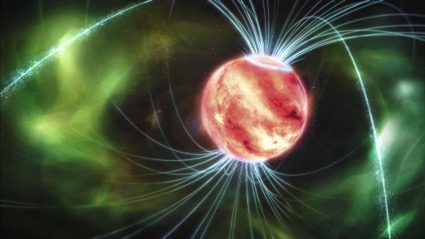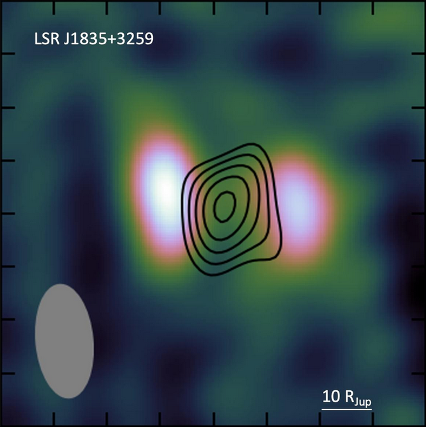
Evidence for a radiation belt around an ultracool dwarf
Ultracool dwarfs (UCDs) are low-mass stars and sub-stellar objects of spectral type later than M6 with some interesting characteristics at radio frequencies. In this work, we used the European VLBI Network (EVN) to observe the fast-rotating UCD LSR J1835+3259, at only 5.6885 ± 0.0015 pc (Gaia Collaboration et al. 2023). The observations revealed a detailed image of the first radiation belt detected beyond the Solar System.

As already known, our observations showed that the radio emission from LSR J1835+3259 is characterized by a quiescent, slowly varying component (gyrosynchrotron and/or synchrotron; Williams et al. 2015, Hughes et al. 2021) and sudden bursts of highly circularly polarised radio emission that have been interpreted as aurorae (Hallinan et al. 2015). However, and for the first time, the great sensitivity of the EVN allowed us to resolve the magnetosphere of the object when it was producing auroral emission, revealing a double-lobed structure strikingly similar to the well-known radiation belts of Earth and Jupiter.

The similarity with Jupiter’s radiation belts is mostly morphological as the diameter of the magnetic structure around the ultracool dwarf is ten times larger than that of Jupiter, and millions of times more powerful. The extraordinary results in LSR J1835+3259 show that the EVN is capable of mapping radiation belts in nearby objects, paving the way to future instruments, such as the Square Kilometre Array, that would extend these studies to smaller and more remote objects, including exoplanets where the knowledge of their magnetic environments is extremely important to calibrate the possibilities of hosting alien life.
________________________________________________
More information:
'Evidence for a radiation belt around a brown dwarf'. J. B. Climent, J. C. Guirado, M. Pérez-Torres, J. M. Marcaide, L. Peña-Moñino. https://www.science.org/doi/10.1126/science.adg6635 . DOI 10.48550/arXiv.2303.06453
Contact:
Juan Bautista Climent
Universitat de València / Valencia International University
E-mail: j.bautista.climent@uv.es
Ph: 655 39 30 08
Jose Carlos Guirado
Universitat de València
E-mail: guirado@uv.es
Ph: 629 50 91 30